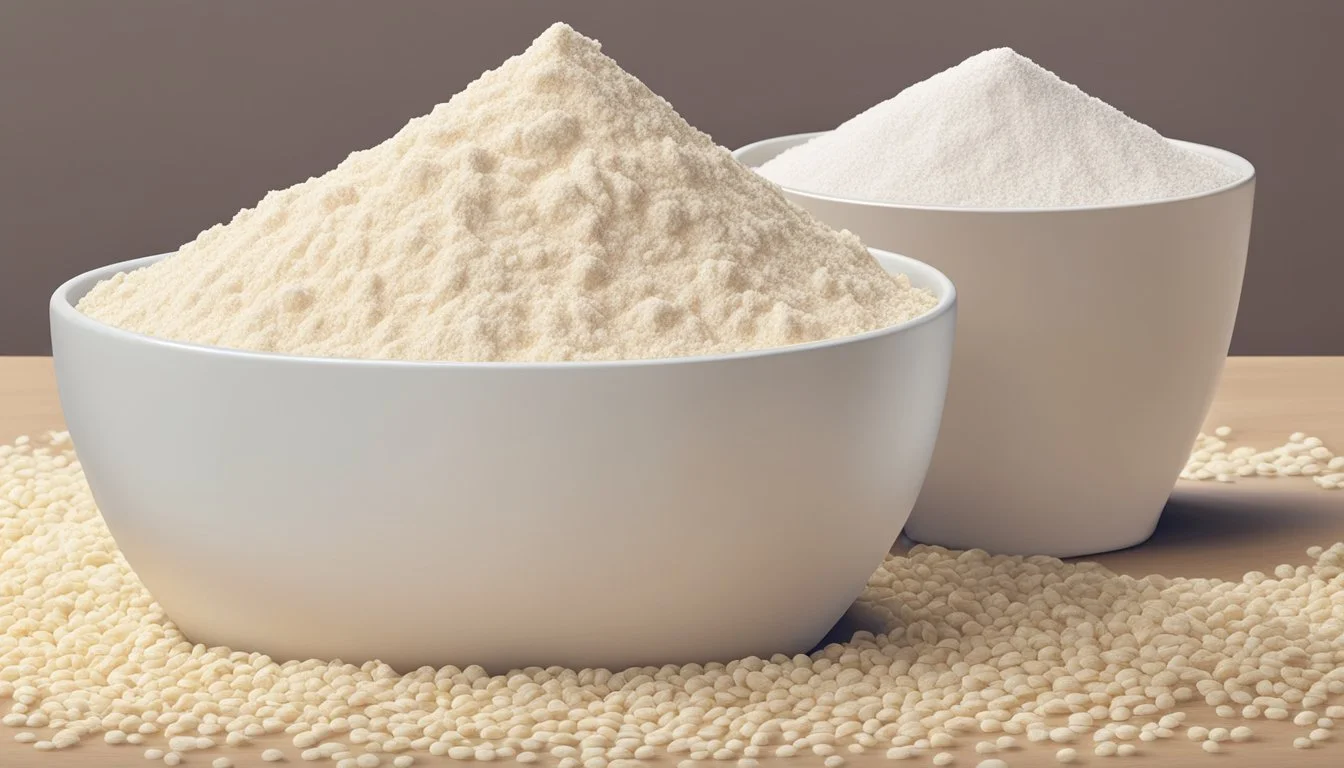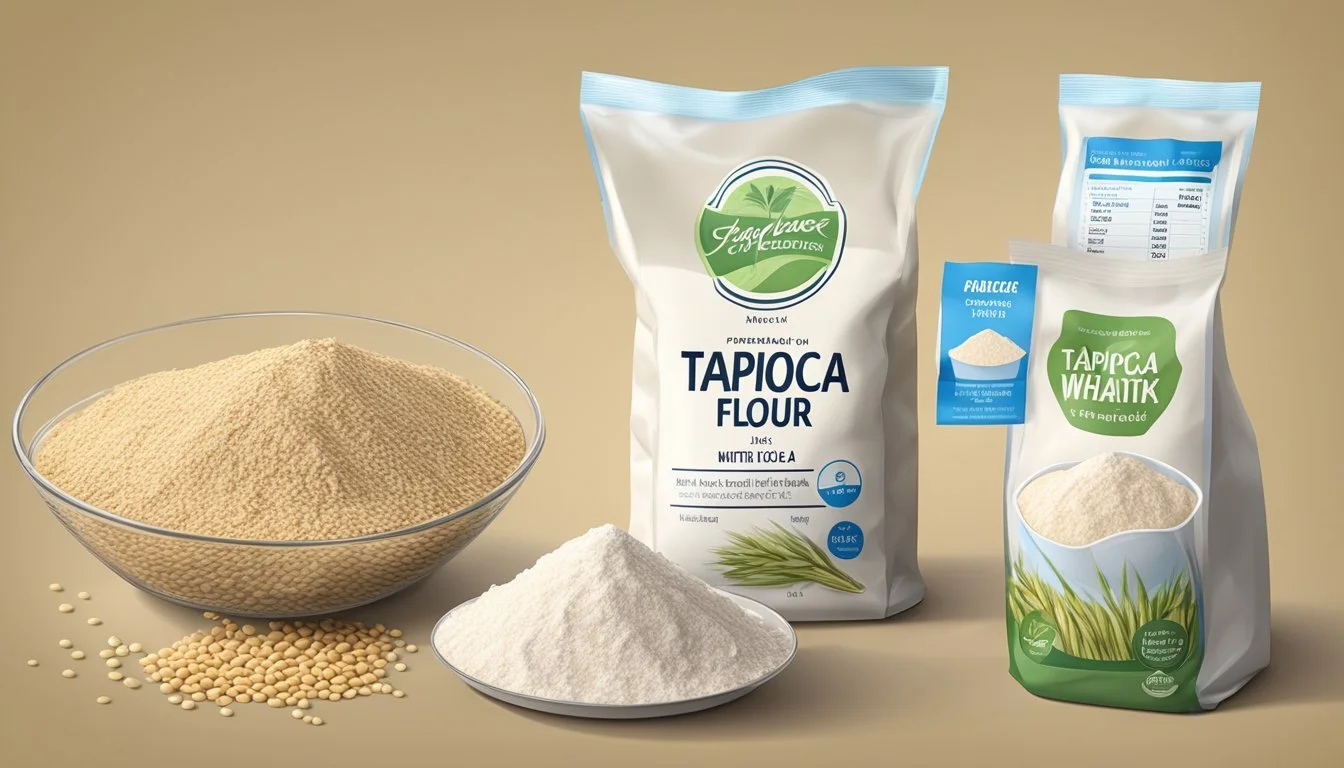Is Tapioca Flour a Nutritious Alternative to Wheat Flour?
Exploring Health Benefits and Uses
Tapioca flour, extracted from the cassava root, shines as a popular wheat flour substitute, especially in the context of gluten-free and allergy-friendly cooking. It's a grain-free, nut-free alternative that presents a safe haven for those who are sensitive to common allergens found in traditional flours. Offering a high carbohydrate content, with a distinctive resistant starch profile, tapioca flour lends a chewy texture and a neutral taste to various baking endeavors, making it a versatile ingredient in the kitchen.
Nutritionally, wheat flour holds an upper hand with a more optimal blend of protein, fiber, and essential minerals such as iron. The distinction between these two flours goes beyond their nutritional composition; it extends to their functional properties in culinary applications. Wheat flour builds structure and elasticity in baked goods due to its gluten content, while tapioca flour contributes to moisture retention and crispiness, often used in combination with other flours to achieve a desirable consistency.
Assessing the nutritional value of tapioca flour in relation to wheat flour requires one to weigh its low fiber and protein content against its utility for those with dietary restrictions. Its role as a substitute hinges not only on its nutritional profile but also on the specific needs and health considerations of the individuals using it. When opting for tapioca flour, one should consider the nuances of their dietary goals and culinary context to gauge its feasibility as a nutritious wheat flour alternative.
Understanding Tapioca Flour
Tapioca flour is a gluten-free baking solution gaining popularity as an alternative to traditional wheat flour. It is known for its versatility in recipes and its digestibility for those with gluten sensitivities.
Origin and Production
Tapioca flour is derived from the cassava root, a staple in many tropical countries. Cassava, when processed, dried, and ground, yields tapioca flour. The production of tapioca flour involves extracting the starch from the roots of the cassava plant, followed by washing and pulping. The starch is then dried to a powdery, flour-like substance.
Composition and Nutrient Content
The primary component of tapioca flour is carbohydrates. It is low in protein, fat, and fiber. As for its nutrient profile, tapioca flour contains minimal vitamins and minerals, making it a pure source of energy but not a nutritious substitute, calorie-for-calorie, when compared to whole-grain flours.
Nutrient Composition per 100g of Tapioca Flour:
Calories: 350
Carbohydrates: 88g
Fiber: <1g
Protein: 0.2g
Fat: 0.02g
Health Benefits and Downsides
Tapioca flour is easily digestible, making it a suitable choice for those with sensitive digestive systems. Being gluten-free, it offers a safe alternative for individuals with celiac disease or gluten intolerance. However, it lacks the fiber found in wheat flour and is not a significant source of vitamins or minerals. Consequently, it should be combined with other nutrient-dense flours and ingredients to create a balanced diet.
Comparing Tapioca Flour to Wheat Flour
When assessing whether tapioca flour is a nutritious alternative to wheat flour, it is essential to consider their nutritional content, usability in recipes, and adaptability for different dietary needs.
Nutritional Profiles
Tapioca flour is a starch extracted from cassava root. It is high in carbohydrates and low in other nutrients. Conversely, wheat flour, particularly in its whole grain form, is more nutrient-dense, providing protein, fiber, and iron which are essential for a balanced diet.
Nutrient Tapioca Flour (per 100g) Wheat Flour (per 100g) Calories 360 340 Carbohydrates 88g 72g Protein 0.2g 13g Fiber 0.9g 11g Iron 1.6mg 4.6mg
Usability in Cooking and Baking
Tapioca flour is gluten-free and offers a chewy texture, making it useful for thickening sauces, soups, and used in baking goods that require elasticity. Wheat flour is versatile for a variety of baked products, such as breads, pastries, and cakes, due to its gluten content, which helps in creating structure and rise in baked goods.
Gluten Content and Dietary Restrictions
Gluten, a protein found in wheat, barley, and rye, is absent in tapioca flour, making it suitable for those with celiac disease or gluten intolerance. Wheat flour contains gluten and is not appropriate for individuals with these conditions. Tapioca flour is often selected as a wheat alternative, not only by individuals with allergic reactions to gluten but also by those who follow a gluten-free diet for lifestyle reasons.
Tapioca Flour in Gluten-Free Baking
Tapioca flour, derived from cassava root, serves as a vital ingredient in gluten-free baking, offering unique benefits concerning texture and flavor.
Advantages for Texture and Taste
In gluten-free baking, the absence of gluten—a protein that gives traditional baked goods their structure and chewiness—often results in products with less desirable textures. Tapioca flour addresses this challenge effectively. When used in gluten-free recipes, it introduces a chewy and dense texture to baked items, which closely mimics the mouthfeel of their gluten-containing counterparts. Moreover, it has a neutral flavor profile that doesn't overpower other ingredients, allowing the intended flavors of cakes, cookies, and pastries to shine through.
Common Uses in Recipes
Tapioca flour's application in gluten-free recipes is both versatile and practical. Here are some common ways it is used:
Cakes and Muffins: Provides moisture retention, ensuring a tender crumb.
Cookies and Brownies: Adds chewiness and crisp edges.
Bread: Imparts elasticity and structure, aiding in the formation of a pleasing texture.
Thickening Agent: Ideal for sauces, gravies, and pie fillings without the gluten.
It's important to note that tapioca flour often works best when combined with other gluten-free flours and starches to achieve a balanced texture and prevent the finished baked goods from becoming too dense or gummy.
Tapioca Flour in Culinary Applications
In culinary arts, tapioca flour has carved a niche for itself, particularly as a gluten-free alternative that excels in thickening and binding. This starch plays a pivotal role in transforming the texture and consistency of various dishes.
Thickening Soups and Sauces
Soups and sauces benefit from tapioca flour's excellent thickening properties. It's a preferred choice because it creates a clear and glossy finish without altering the taste. To use tapioca flour as a thickening agent:
Measure: Start with 1 to 2 tablespoons of tapioca flour for each cup of liquid.
Mix: Combine it with a small amount of cool water to create a slurry.
Stir: Gradually stir the slurry into your hot soup or sauce.
Heat: Continue to cook until the desired thickness is achieved, usually for a few minutes.
Tapioca flour thickens quickly, and it's essential to keep in mind that overcooking could lead to sliminess.
Binding Agent for Baked Goods
In baked goods, tapioca flour is not just a gluten-free substitute; it serves as an exceptional binding agent that ensures structure and moisture retention in products like breads, flatbread, pizza dough, and pie fillings.
Breads and Flatbread: Replaces wheat flour completely or as part of a flour blend to add chewiness and help bind the ingredients together.
Pizza Dough: Enhances the dough's pliability and ability to hold shape after rising.
Pie Filling: Prevents fruit fillings from becoming watery, giving pies a desirable consistency.
For optimal results, bakers often combine tapioca flour with other gluten-free flours to mimic the texture and density of traditional wheat-based recipes.
Health Considerations
When evaluating tapioca flour as a nutritional alternative to wheat flour, one must consider its impact on health, particularly regarding blood sugar management and potential anti-nutrients.
Impact on Blood Sugar and Diabetes
Tapioca flour is high in carbohydrates and has a tendency to cause a rapid increase in blood sugar levels, due to its high glycemic index. For individuals with diabetes, this can complicate blood sugar management. Its carbohydrate content is mostly starch, and while resistant starch has certain health benefits, such as improved insulin sensitivity, the type present in tapioca flour may not have the same positive effects.
Factor Tapioca Flour Wheat Flour Glycemic Index High Moderate to High Blood Sugar Impact Rapid Increase Gradual to Rapid Increase Suitability for Diabetics Less Suitable Depends on Wheat Type
Anti-Nutrients and Toxicity
While wheat flour contains allergens like gluten that may affect individuals with celiac disease or gluten intolerances, tapioca flour is naturally gluten-free, making it an attractive option for these populations. However, it is worth considering that raw tapioca contains compounds that can convert to cyanide in the body. Processing removes these compounds, but one should ensure that tapioca flour is sourced from reputable manufacturers to avoid the risk of cyanide toxicity.
Allergens: Gluten in wheat flour vs. gluten-free tapioca flour.
Cyanide: Care must be taken to source properly processed tapioca flour.
Alternatives to Tapioca Flour
When seeking alternatives to tapioca flour, one has various gluten-free and nut or seed flour options. These alternatives offer distinct nutritional profiles and culinary properties suited to different dietary needs and cooking applications.
Other Gluten-Free Flours
Cornstarch: A common thickening agent, cornstarch serves as a direct substitute for tapioca flour. It is widely available and works well in distributing a silky texture to sauces and fillings.
Rice Flour: Comparable in weight to tapioca flour, rice flour is utilized for a range of baking applications, although it can contribute a somewhat sandier consistency.
Buckwheat Flour: Buckwheat flour, despite its name, is gluten-free and imparts a robust, earthy flavor to baked goods.
Oat Flour: Made from ground oats, oat flour lends a mild, slightly sweet taste and can enhance the moisture content in recipes.
Chickpea Flour: High in protein and fiber, chickpea flour is a nutritious alternative used in baking and as a binder in various dishes.
Arrowroot: A root starch similar to tapioca, arrowroot can be substituted in a 1:1 ratio for thickening sauces and is known for its neutral flavor and glossy finish.
Nut and Seed Flours
Almond Flour: Rich in protein and healthy fats, almond flour is a staple in grain-free and low-carb baking due to its fine texture and buttery flavor.
Coconut Flour: Highly absorbent and rich in dietary fiber, coconut flour requires an adjustment in the amount of liquid used in recipes and imparts a subtle coconut taste.
Nut Flours (General): Other nut flours, such as hazelnut or walnut flour, offer unique flavors and are suitable for grain-free options, although they may not be direct substitutes in terms of consistency or absorption rates.
Creative Uses of Tapioca in Cooking
Tapioca flour emerges as a versatile ingredient in the kitchen, offering both function and flair across a wide variety of culinary applications. It excels in providing texture and consistency to dishes, seamlessly integrating into numerous traditional and modern recipes.
Cultural and International Dishes
Countries around the globe have long utilized tapioca in traditional cooking. In Brazil, tapioca pearls are used in a popular dish called Bobó de Camarão, a creamy shrimp stew thickened with these pearls. Southeast Asian cuisine features tapioca prominently in desserts like the sweet and chewy tapioca puddings.
In India, sabudana khichdi, made from soaked tapioca pearls, is a staple during fasting periods. Alternatively, they form the basis of transparent noodles in Thai desserts, adding a unique texture. Tapioca's ability to absorb flavors and provide a gelatinous consistency makes it ideal for culturally diverse dishes ranging from savory to sweet.
Innovative Culinary Trends
Tapioca's adaptability has placed it squarely at the forefront of innovative culinary trends. Boba, or bubble tea, showcases the use of sweetened tapioca pearls, originating in Taiwan and gaining a loyal following worldwide. These chewy balls are now synonymous with the drink and are often infused with various flavors to enhance the bubble tea experience.
Forward-thinking chefs have adopted tapioca flour as a gluten-free baking alternative, creating breads and pastries that are lighter in texture. They're also experimenting with tapioca flour in gluten-free flatbreads or crusts, where it provides a desirable chewiness and moisture retention that is often lacking in gluten-free options. Tapioca flour's neutral flavor and quick thickening properties make it an essential ingredient in modifying traditional recipes to suit contemporary dietary preferences.





